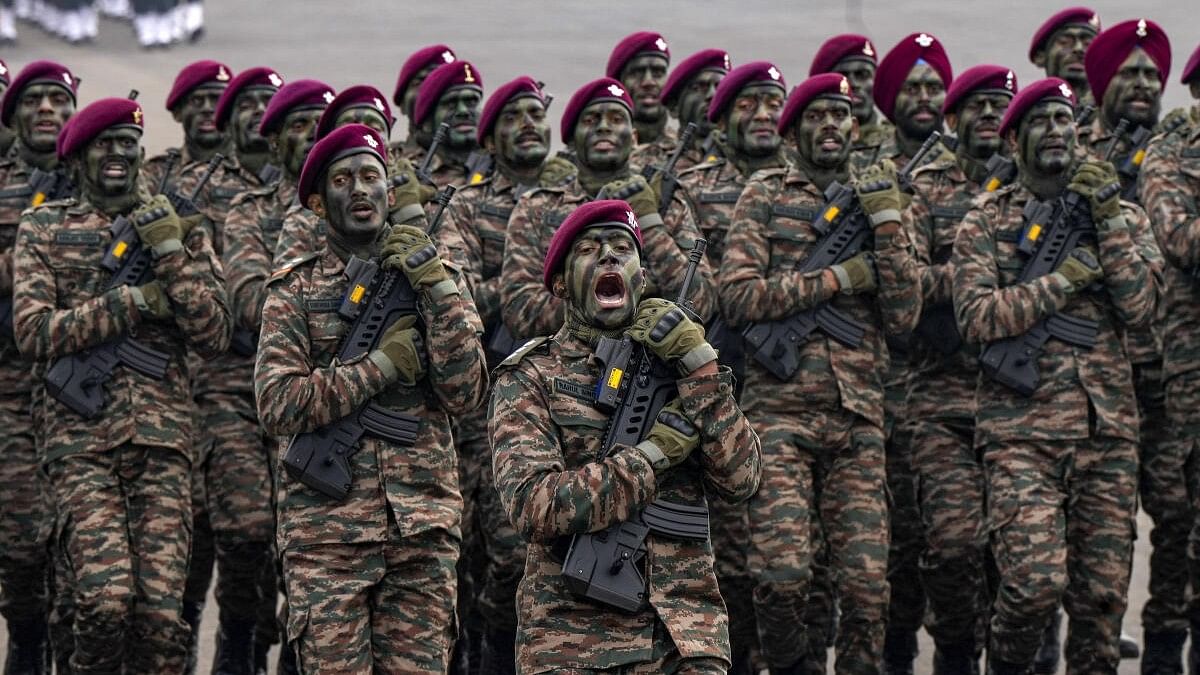
A contingent marches past during Army day celebrations
Credit: PTI Photo
Elections are often barometers indicating the shape of things to come in a country’s national security domain as a new government takes office.
In the Indian context, the new government has its task cut out on national security as the priorities of defence planners have seldom been clearer: changing geopolitical realities such as an assertive China’s arms build-up, political and economic instability in neighbouring countries, and the insurgencies in some restive states.
The military being a key instrument in addressing these challenges, the new government is expected to recalibrate India’s defence posture by reviewing these challenges vis-à-vis the armed forces. Given the blurred lines separating India’s internal and external security situations, with the military often called upon for internal conflict resolution, it is an enormous drain on defence resources. This makes it challenging for the armed forces to maintain combat capabilities while simultaneously pressing ahead with the Ministry of Defence (MoD)’s two-pronged reform and modernisation programmes.
One of the immediate focus areas for the new government is the restructuring of the tri-services commands in the armed forces: the centrepiece of defence reforms. Almost three years after an exclusive Department of Military Affairs was set up in 2021, the establishment of integrated theatre commands (ITCs) for jointness in operations is nowhere near completion. The proposed force structure will have the Chief of Defence Staff (CDS) presiding over the ITCs whose commanders report directly to the CDS, which is the practice in advanced militaries like that of the United States. This is to ensure that financial, materiel, and operational capability resources are shared optimally by the ITCs, unlike the current practice of the armed forces achieving joint operations only at the tactical level.
That there has been no substantial movement on the establishment of ITCs so far has a lot to do with the stiff resistance from the Indian Air Force (IAF) which is loath to share its aircraft with disparate theatres, especially those commanded by non-IAF officers. It would be interesting to see how the government tackles this key issue of inter-service harmony, and speed up theaterisation.
Another factor blocking the ITCs is the conspicuous absence of a National Security Strategy (NSS) to spell out India’s security objectives and strategies. Proposed more than 20 years ago, it is unfortunate that the NSS remains a work in progress. Defence planners must address this urgently because without an NSS the strategic calculus is opaque to the military, which is technically in the dark as far as its exact mission beyond defending the country and its island territories is concerned.
Creating a procurement system based on an indigenous production capability is another critical requirement for the military. The government will undoubtedly seek to build on the success of the ‘Make in India’ programme as it uses ‘atmanirbharta’ (self-reliance) in defence manufacturing to guide future acquisitions. An indicator of this is the regularity with which advanced indigenously developed missile systems are rolling off the Defence Research and Development Organisation (DRDO)’s drawing boards. Nevertheless, these are very early days for achieving self-reliance in arms manufacture, and India still needs to shop for key weapon platforms in the international market, be it fifth-generation fighter jets, combat drones and anti-drone systems, air defence systems, or artillery guns.
In the military’s indigenously-based modernisation effort, the Indian Navy (IN) is steaming ahead of the army and the IAF, with shipyards currently building more than 40 vessels of different types. However, it cannot be denied that even the IN’s declared goal of having a 175-ship fleet in the next 10 years pales before China’s rapidly expanding People’s Liberation Army Navy (PLAN). The rate at which PLAN is growing, it will have expanded to a mammoth fleet of 435 ships, including supercarriers and submarines, by 2035. Asymmetries to a lesser extent exist in the land and air forces too vis-à-vis India’s eastern neighbour.
While New Delhi cannot match Beijing’s colossal defence spends — India’s defence budget is barely 28 per cent of China’s — and play the numbers game, it could turn to adroit policymaking to meet these challenges. For instance, the IN could augment its sea-denial capabilities with theaterised resources using land-based air power to counter PLAN’s attempts to dominate the seaways near, say, the Maldives or the Straits of Malacca.
Defence planners must learn to juggle a modest budget with personnel costs, weapons acquisition, and upgrades in the three services, besides ensuring wider industry participation in defence procurement. The next five years offer the government a unique opportunity to tap the immense potential of India’s civilian scientific base to develop frontier technologies, and innovative capabilities for the armed forces. This will help realise a robust military-industrial ecosystem in the subcontinent that is so essential to meet the technological challenges on the 21st-century battlefield.
(This article is the second in a series of articles on the challenges and opportunities before the next Union government.)
(Prakash Chandra is former editor of the Indian Defence Review. He writes on aerospace and strategic affairs.)
Disclaimer: The views expressed above are the author's own. They do not necessarily reflect the views of DH.